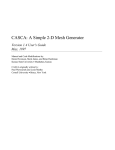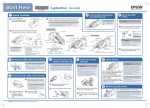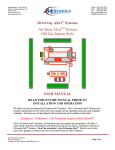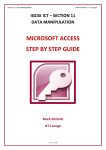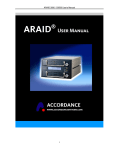Download to BEV, WINE, ICE User Manual.
Transcript
BEV – WINE – ICE Upright Display Freezers & Coolers KIC Upright Freezers & Coolers General Instruction Manual Contents: 1. 2. 3. 4. 5. 6. 7. 8. 9. Installation Environmental Conditions Accessories Environmental Information Periodical Maintenance Troubleshooting Guide Seasonal Use Settings & Controls Door Reversal Thank you for choosing this product. We are sure you will find you have made a sound investment and this appliance will prove as such. Our appliances are designed to give the best possible performance under the safest and most economical conditions. This appliance has undergone our thorough and strict controls throughout the production process. In order to avoid risks to the user, damage to the cabinet or jeopardy of the performance, follow the instructions here carefully. Our company declines any responsibility for any lack of performance due to alterations or modifications to the unit (removal or addition of electrical or mechanical parts) or by non compliance of the instructions in this manual. 1. INSTALLATION After removing the packaging, carefully clean the whole cabinet; in order to do that see section 5. PERIODICAL MAINTENANCE Do not install the unit in open spaces and do not expose it to the rain, the external environmental conditions for the regular use of the unit are specified in section 10. TECHNICAL DATA 1. The cabinet must be installed on a clear and level surface and must be perfectly levelled using the adjustable feet. 2. Place the cabinet in a well ventilated place far away from heating sources (radiators, cookers etc) and not directly exposed to the Sun. To illuminate the cabinet, it is advisable to use fluorescent lamps. 3. The cabinet must be placed against the wall but before leaning it, check the instruction kit to see if there are spacers to rest it on its back. In case it must be moved, first take the socket off the current tap. 4. The cabinet can be equipped with a lock (Optional). In that case, keep keys out of reach of children. 5. Inspect the cabinet thoroughly to ensure that no damage has been caused during transit. WARNING!! Never wet any cabinet part where electrical components are present. Never force any cabinet part where refrigeration cycle components are present. The cabinet is not suitable for working in dangerous places with risk of fire, explosion and/or radiation. PUTTING IN OPERATION Before plugging the unit into the mains, let the unit stand for at least an hour. If the unit has been transported laid down, it is advisable to wait 24hrs. Check that the mains voltage corresponds to that on the technical data plate. Do not place anything on the cabinet (Plants, Boxes, etc) and leave a free space of minimum 50cm above the cabinet The electrical line where the unit will be connected must be protected by any high sensitivity differential switch (1n=16A, 1d=30mA) and earthed appropriately. The earthing of the installation is a safety standard which is enforced by law. Our company has provided for this connection according to the existing standards and we therefore decline any responsibility for any damage to persons or property When connecting to the mains, do not use any multiple sockets. After connecting to the mains, run the cabinet for at least 2 hours empty and unlit. Then load the cabinet, do not load products over the edge of the shelves because the front edge temperature is not sufficient for preservation purposes, over the rear edge could cause obstruction to the circulation of refrigerated air. CHECK THE TEMPERATURE VALUES OF THE CABINET IN ORDER TO DETERMINE WHAT KIND OF FOOD IS SUITABLE TO PRESERVE IN. (SEE 10. TECHNICAL DATA) 2. ENVIRONMENTAL CONDITIONS Since an excess of humidity does not allow the cabinet to work properly, it may be necessary to install an air conditioner in the room where the cabinet is installed. This allows the control of relative humidity and keeps the environmental conditions within the limit stated in TECHNICAL DATA. The cabinet must be placed away from forced air sources (in/outlet of fans/air conditioner or radiators) and also from places where there may be air draughts. 3. ACCESSORIES Use only the accessories included with the cabinet. Any self-made accessories can hinder air circulation and therefore the cabinet will not function properly. 4. ENVIRONMENTAL INFORMATION PACKING The packing is 100% recyclable and has the recycling logo printed on it For disposal, follow local guidelines. The plastic bags and polystyrene must be kept away from children as they may be dangerous. PRODUCT To eliminate the compressor oil and Freon gas, follow local laws and guidelines for the appropriate disposal and recycling of such. To decommission from use, sever the feeding cable and remove the door. 5.PERIODICAL MAINTENANCE Before making any adjustments to the refrigeration, disconnect the cabinet from the mains electrical supply. The mechanical parts of this cabinet do not need any periodical maintenance, however to maintain the performance of the cabinet, thorough periodical cleaning is necessary. EXTERNAL BODY: The exterior of the cabinet must be cleaned with a soft dry cloth. To remove stains, use warm water and a neutral soap then rinse well and dry. STAINLESS STEEL SURFACES: Wash with warm water and neutral soap, rinse well and dry with a soft cloth. Avoid use of alcohol, methylated spirits and other solvents. SURFACES IN PLASTIC MATERIALS: Wash with water and neutral soap, rinse well and dry with a soft cloth. Avoid the use of alcohol, methylated spirits or other solvents. GLASS SURFACES: Only use glass specific cleaning products. Avoid using water that could leave a film of calcium on the glass surfaces. CLEANING THE INTERIOR OF THE CABINET: Switch off the unit and disconnect from mains supply Remove the produce and shelves from the cabinet Leave the door open and wait until the cabinet reaches the ambient temperature Wash the inside of the cabinet with warm water and a neutral soap, then dry it with a cloth. Do not use high pressure jets or hoses to clean the cabinet as electrical wiring could be damaged. Replace the shelves and switch the cabinet on with the light off, after 1 hour the cabinet is ready and you may restock with produce. Once a year, clean the door seal with warm water and neutral soap. Rinse well and dry, afterwards you should apply a light layer of Vaseline to keep the seal soft and flexible. DO NOT USE POINTED OR CUTTING OBJECTS THAT COULD DAMAGE THE SEAL!! CONDENSOR CLEANING: WARNING: The following is only to be carried out by a suitably qualified person. The condenser should be cleaned at least twice per year in order to remove dust and impurity which may obstruct the air flow. A dirty condenser could affect the performance of the cabinet and may increase the energy consumption. The cleaning is to be carried out with a bristle brush, or preferably a vacuum cleaner. Wherever required, remove the protection grid. Before moving the cabinet or handling the plant, disconnect from the mains. MANUAL DEFROSTING Due to the condensing of the humidity in the air, a layer of frost may form inside the cabinet which affects the performance of the machine. Therefore it may be necessary to remove this with a plastic scraper. When this layer is thicker than 4-5mm, the machine must be defrosted as follows: Where applicable, remove the plastic T-shaped plug on the bottom front of the cabinet and put in a suitable water drainage pipe. Place a bin under to collect the water. In the event of there being no pipe, the water drainage cycle is automatic. For the negative models with static cold, take off the T-shaped plug on the bottom front of the cabinet and fit in the place suitable for the release of water, afterwards, place a pouring basin underneath. Roll Bond models, the drain is to be found on the back of the cabinet. Use either a plastic scraper or a sponge soaked with warm water to assist the water evacuation. Take off the water and dry the inside well. Plug in the cabinet and once the appropriate temperature has been reached, replace the goods inside the cabinet. LCD THERMOMETER BATTERIES REPLACEMENT Attention: The following procedure must be carried out by a suitable qualified person. Disconnect the unit from the mains supply Take off the silk-screened switchboard protection with a pointed scraper; unscrew the 2 cross head screws and pull the plastic covering the switchboard out. Take the thermometer out and replace the batteries, install it in its seat again. Reassemble the plastic covering the switchboard with its screws and fit the silk screened protection in again. Take off the lamp lock screen from its seat with a screwdriver. If the cabinet is to be unused for a length of time: Disconnect from the mains and clean the cabinet well. Leave the glass door open to prevent the formation of odours. Cover the cabinet with a curtain or similar and place it in a dry room. ANY UNUSUAL MAINTENANCE MUST BE CARRIED OUT BY A SUITABLE QUALIFIED PERSON!! FAULT FINDING & SOLUTIONS Most of the faults encountered are generally down to misuse or faulty electrical connections. These can be easily rectified. The Unit Does Not Start Check there is power at the wall socket Check that the unit is properly plugged in The Internal Temperature Is Not Cold Enough Check that the door is securely closed and sealed and that there is nothing obstructing the closure. Check the cabinet is not placed to close to a direct heat source Check the cabinet is against the wall and the front grill is free from obstruction. Check the thermostat position. Check the condenser is not blocked by dirt, use a wire brush or vacuum to clear it. The Unit Is Noisy Check all nuts and bolts are secure Check if any pipes or blades touch any other parts of the cabinet Check that the cabinet is on a level surface. If There Is Moisture Inside The Cabinet It is normal during periods of high humidity Part of this humidity must be considered normal where the produce is not wrapped or if they are in open containers. It can be caused by frequent or extended opening of the door. If the inside light is defective, it can be replaced directly by the user. IF THE FAULT PERSISTS, PLEASE CONTACT YOUR SERVICE ENGINEER HOW TO REPLACE THE LIGHTS INSIDE LAMP Remove the plug from the socket Take the lamp-lock off its seat with a screwdriver Take off the light screen making it move on the right and then gently press it downward Replace the light Reverse the operation to replace the light CANOPY LAMP Remove the plug from the socket Unscrew the fastening screws to take off the canopy Replace the light Reverse the operation to place the light 7. SEASONAL USE AND/OR NON-USE When the cabinet will not be used for a length of time, please proceed as follows: Disconnect from the mains and clean the cabinet well. Leave the glass door open to prevent the formation of odours. Cover the cabinet with a curtain or similar and place it in a dry room. When the cabinet will be started up again: Repeat the electrical check given in PUTTING INTO OPERATION Wait for at least 2 hours before placing products inside. SETTINGS & CONTROLS The control panel is on the front of the cabinet situated at the top 1. Lights Switcher To light the inside lamp (also canopy light where applicable) 2. Thermometer The inside temperature is indicated on the horizontal reading thermometer 3. Thermostat To regulate temperature, use the manual thermostat on the control panel. Turn left to raise the temperature and right to reduce it. 4. Electrical Thermostat Only where applicable, for details see booklet attached for directions of use of the thermostat 9. DOOR REVERSAL WARNING: The following procedure should only be carried out by a suitably qualified person. Take off the plug and empty the cabinet Lean the cabinet backwards 45˚ use a support if available. Prop the cabinet to prevent slipping Unload the torsion bar, take out the adjusting screw levering with the help of a tool inserted in one of its holes Slide down the door releasing the upper and lower hinges Take out the silk screened protection of the control panel with the help of a scraper; take off the two screws and the plastic cover Unscrew the nut 12-MA placed on the right of the support and take out the pivot of the hinge. Remove the lower hinge Reassemble everything on the left side without blocking the nut Unscrew the screw 5 which closes the torsion bar on the door frame and take it out. Also remove the roller blocking the door Turn the door 180˚ and reassemble the torsion bar on the roller Replace the door frame on the pivot of the upper hinge and reassemble the lower hinge and the support of the roller Line up the door with the cabinet sides and afterwards block the hinges Strain again the torsion bar and screw the bolt with the help of a tool Replace the plastic cover on the control panel with suitable screws and reassemble the silk screened protection Stand the cabinet up again and wait for about an hour to put the plug into the socket and start the machine.








